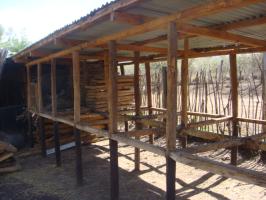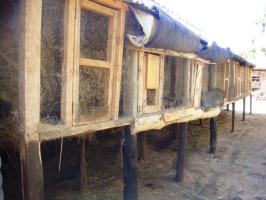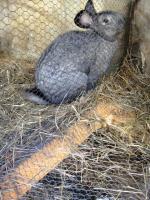Credits: Biovision-Infonet
The rabbit unit should be located in a peaceful environment, away from the noise and bustle of human and animal noise. The unit must fulfill the following function:
a) protection from extreme influences of weather and noise, which could interfere with the performance of the rabbits
b) protection from predators including birds, snakes, insects and rats. While planning a unit, the following should be taken into consideration:
- The exterior should provide protection against heat but at the same time it should be properly ventilated without draughts.
- There should be separate units for the does and bucks. Breeding stock should be kept in one unit and the ‘meat’ unit should be separate.
- Three or 4 does and one buck would be more than sufficient to keep a household supplied with meat all year round. You would therefore need:
- A pen for the buck
- A pen for each doe
- At least 2 weaning pens – one for females and one for males
If there are more does, you need more pens for the does but also more weaning pens. When the weaners are growing not so fast because of lower feed quality, they stay longer and more weaning pens are needed.

(c) S. Fontana, BioVision
To grow healthy, rabbits must be kept clean because dirty rabbits are unhealthy rabbits. It is best to house them off the ground as follows:
- The house should be 90 cm off the ground, should be 90 cm high and 90 cm wide. As roofing sheets come in 2.5 meter lengths it makes sense to build blocks of houses 1.8 m wide so one roofing sheet can be used to cover 2 houses.
- The floors should consist of chicken wire (with the smallest size holes) so that droppings and urine fall through to the ground. This can then be swept up daily and used to mix with compost.
- The house should have a layer of hay/dried grass or straw as bedding. This is a very important part of the rabbit’s diet. They will eat a lot of this bedding during the night.
- Rabbits do not tolerate windy conditions, so houses should be placed in sheltered areas and windbreaks provided where appropriate.
- Rabbit houses should be cleaned every day. Wet bedding should be removed and replaced with dry material. If rabbits are left with soiled beddingt, hey will not eat the bedding material and it will encourage flies and diseases to multiply.
- Dirty or wet houses will result in a very strong ‘rabbit’ odour which will taint the meat. A soiled pen is stressful for the rabbit and it will also mean that the pelts become soiled and ‘felted’ which makes them unusable.
- Mud hutches and thatched houses can also be constructed but they should be off the
- ground and kept clean as described above.
- NEVER be tempted to try and save space by constructing houses in ‘tiers’ (one on top of another). This will lead to all kinds of problems as the lower houses will become fouled by the droppings and urine from the upper level.
- Exposure to light plays an important role in reproductive efficiency. Bucks exposed to light for 8/24 hours are more sexually active. It also improves the productivity of the doe. It is possible to make up this light requirement using artificial light, but this is an expensive way of solving the problem.

(c) S. Fontana, Biovision

(c) S. Fontana, Biovision

(c) S. Fontana, Biovision